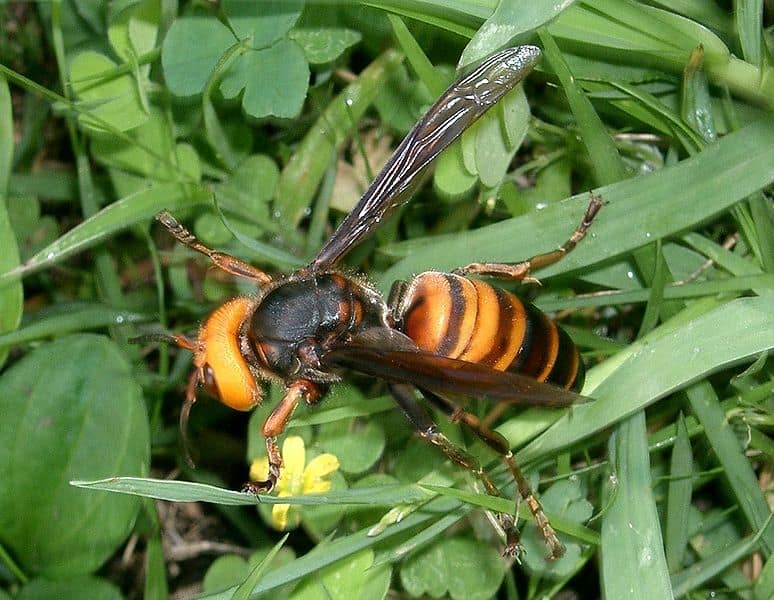
The post Thousands of Murder Hornets Furiously Swarm a Man Trying to Remove Their Nest appeared first on A-Z Animals.
Northern giant hornets (Vespa mandarinia), also known as Asian giant hornets, are an invasive species in North America but have since been eradicated. In order to eradicate them, entomologists had to track and kill the insects. This dangerous work would not have been possible without protective gear. One chilling video shows people clothed in special protective suits as they are swarmed by massive hornets.

Asian giant hornets are often referred to as great sparrow bees in their native home of Japan.
©David Carillet/Shutterstock.com
What Is an Asian Giant Hornet?
The Asian giant hornet, also known as the northern giant hornet or sparrow bee, is not the largest wasp in the world. That honor goes to the giant tarantula-hawk wasp (Pepsis heros) that can reach over four inches in length. However, Asian giant hornets are the largest social wasps and may grow to around two inches long.
Giant hornets live in colonies with a queen and workers. They like to build nests low to the ground or underground in abandoned burrows or the cavities of tree roots. They are identified by their banded yellow, black, and brown abdomens and large orange heads. Scientists suspect that northern giant hornets arrived in the U.S. in shipping containers from Asia. The largest threat northern giant hornets pose in the country is to native insects and the agricultural industry.
Are Giant Hornets Really ‘Murder Hornets’?
Native to Asia, giant hornets can be found in India, Japan, Southeast Asia, and parts of the Russian Far East. They were given the nickname “murder hornets” when they were found living in Washington State and British Columbia, Canada. But are they really as dangerous as they seem?
Giant hornets are venomous, but their venom is less toxic than many other wasp species. The problem lies in how many times you might get stung by an Asian hornet. They defend their nests vigorously, attacking as a group. Their venom can be dangerous to young children, pets, and people with allergies. They also have longer stingers than native wasps and bees. These long stingers can pierce normal beekeeping attire, which requires the need for special biotech suits.

Agriculture officials from the Washington State Department of Agriculture and the USDA wore special protective biotech suits when working with northern giant hornets.
©U.S. Department of Agriculture USDA APHIS photo by Stacy Herron/USDA APHIS photo by Stacy Herron, Public domain, via Wikimedia Commons – Original
You can see exactly what it’s like to disturb a nest of giant hornets in a YouTube short posted by @VashumEndeavor. The video shows people in biotech suits breaking up Asian giant hornet nests. The hornets are defending their nests by swarming the people. Interestingly, the hornets appeared to focus their stinging on the people’s heads and necks. Without the biotech suits, these people would have been stung many thousands of times.
This viral video had a number of comments from people terrified of the wasps, including one person who said, “That’s when you just need to give up and call in an airstrike.”
Asian Giant Hornets Are Murder Hornets When It Comes to Honeybees
Unless you disturb their nest, giant hornets won’t hunt or attack people. But that’s not true when it comes to honeybees. Giant hornets attack and eat honeybees, and they can kill off an entire honeybee colony within a few hours. Experts describe it as a “slaughter phase” where the hornets decapitate the bees. They will then take the brood back to feed their own young.

Northern giant hornets attack and kill honeybees, and can wipe out an entire honeybee colony in a matter of a few hours.
In areas where giant hornets are native, the honeybees have developed defense mechanisms to protect themselves from hornet attacks. Japanese honeybees will swarm around the hornets, forming a sort of bee ball around the intruder. However, honeybees in North America have no such defense and are completely vulnerable to giant hornet attacks.
Georgia Tech Professor Mike Goodisman said in a statement, “A threat to the honeybee population would be a commercial disaster. Honeybees are critical in agriculture for pollinating a great variety of the foods we eat, and if we don’t have these pollinators, then we wouldn’t have many of the foods — fruits especially — that we are used to.”
How Did Scientists Get Rid of the Northern Giant Hornets?
Entomologists set hornet traps in Washington state, where the hornets were first spotted. Scientists then tied tiny radio trackers to the hornets using dental floss. Once the scientists located the hornet nests, they donned protective suits, plugged the nest with foam, and wrapped the tree in plastic to try to keep the escaping hornets to a minimum. Finally, they vacuumed out the hornets and injected carbon dioxide into the tree to kill any that had been left behind.
Although northern giant hornets have been eradicated from Washington, officials are always on the lookout in case they return. Goodisman explained that giant hornets can hibernate in many different materials and make their way to other countries aboard cargo ships.
The post Thousands of Murder Hornets Furiously Swarm a Man Trying to Remove Their Nest appeared first on A-Z Animals.
May 29, 2025 at 05:02PMJennifer Geer
.jpeg)
.jpeg)

0 Comments